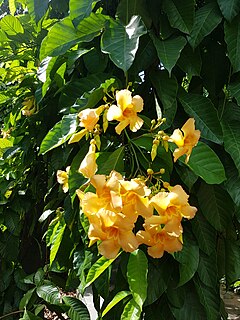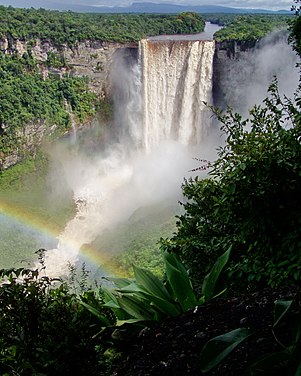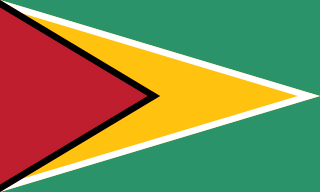
The Guiana Shield is one of the three cratons of the South American Plate. It is a 1.7 billion-year-old Precambrian geological formation in northeast South America that forms a portion of the northern coast. The higher elevations on the shield are called the Guiana Highlands, which is where the table-like mountains called tepuis are found. The Guiana Highlands are also the source of some of the world's most spectacular waterfalls such as Angel Falls, Kaieteur Falls and Kuquenan Falls.

Couratari is a genus of trees in the family Lecythidaceae, first described as a genus in 1775. They native to tropical South America and Central America.
Aspidosperma vargasii is a timber tree native to Venezuela, Colombia, Peru, Guyana, and Suriname.
Corythophora is a genus of woody plant in the Lecythidaceae family first described as a genus in 1939. It is native to northeastern South America.
- Corythophora altaR.Knuth - Pará, Amazonas
- Corythophora amapaensisPires ex S.A.Mori & Prance - French Guiana, Amapá
- Corythophora labriculata(Eyma) S.A.Mori & Prance - Suriname
- Corythophora rimosaW.A.Rodrigues - French Guiana, Amazonas, Amapá, Suriname

Lecythis is a genus of woody plant in the Lecythidaceae family first described as a genus in 1758. It is native to Central America and South America.
Anaphyllopsis is a genus of flowering plants in the family Araceae, native to northern South America.
Rehia is a genus of plants in the grass family. The only known species is Rehia nervata, native to Brazil and to the Guianas.
Froesiochloa is a genus of South American plants in the grass family. The only known species is Froesiochloa boutelouoides, native to Guyana, French Guiana, and Brazil.
Glossarion is a genus of South American flowering plants in the daisy family, Asteraceae.
- Glossarion bilabiatum(Maguire) Pruski - Amazonas State in Venezuela and Amazonas State in Brazil
- Glossarion rhodanthumMaguire & Wurdack - Amazonas State in Venezuela and Amazonas State in Brazil
Neblinaea is a genus of flowering plants in the daisy family, Asteraceae.
Aechmea poitaei is a species in the genus Aechmea. This species is native to Ecuador, Colombia, Peru and French Guiana.
Uleiorchis is a genus of myco-heterotrophic flowering plants from the orchid family, Orchidaceae. There are two known species, native to Central and South America.
Bulbophyllum pinelianum, the rat-tail orchid, is a species of orchid in the genus Bulbophyllum. It is widespread across southern Mexico, the West Indies, Central America and northern South America. It is also reported from Florida but apparently now extinct in that state.
Hylaeorchis is a genus of epiphytic orchids. There is only one known species, Hylaeorchis petiolaris, native to northwestern South America.

Odontadenia is a genus of plant in the family Apocynaceae, first described as a genus in 1841. It is native to southern Mexico, Central America, South America, and the West Indies.
- Odontadenia anomala(Van Heurck & Müll.Arg.) J.F.Macbr. - Peru, Bolivia
- Odontadenia campanulataJ.F.Morales - Colombia
- Odontadenia funigeraWoodson - Venezuela, Colombia, Ecuador, Peru, Brazil
- Odontadenia geminata(Hoffmanns. ex Roem. & Schult.) Müll.Arg. - 3 Guianas, Venezuela, Colombia, Ecuador, Peru, Bolivia, N Brazil
- Odontadenia glaucaWoodson - Amazonas State in S Venezuela
- Odontadenia gracilipes(Stadelm.) Woodson - Minas Gerais
- Odontadenia hypoglauca(Stadelm.) Müll.Arg. - Bolivia, Brazil
- Odontadenia killipiiWoodson - French Guiana, Venezuela, Colombia, Ecuador, Peru, N Brazil
- Odontadenia kochiiPilg. - Guyana, Venezuela, Colombia, Ecuador, Peru, N Brazil
- Odontadenia laxiflora(Rusby) Woodson - Peru, Bolivia, N Brazil
- Odontadenia lutea(Vell.) Markgr. - Peru, Bolivia, Brazil
- Odontadenia macrantha(Roem. & Schult.) Markgr. - Oaxaca, Chiapas, Central America, Trinidad & Tobago, 3 Guianas, Venezuela, Colombia, Ecuador, Peru, Brazil
- Odontadenia markgrafianaJ.F.Morales - French Guiana, N Brazil
- Odontadenia matogrossanaJ.F.Morales - Goiás, Mato Grosso
- Odontadenia nitida(Vahl) Müll.Arg. - Trinidad & Tobago, 3 Guianas, Venezuela, Colombia, Ecuador, Peru, Brazil, Bolivia
- Odontadenia perrottetii(A.DC.) Woodson - Venezuela, Colombia, Brazil, Bolivia, Guyana, French Guiana
- Odontadenia polyneura(Urb.) Woodson - Hispaniola
- Odontadenia puncticulosa(Rich.) Pulle - Central America, 3 Guianas, Venezuela, Colombia, Ecuador, Peru, Brazil, Bolivia
- Odontadenia stemmadeniifoliaWoodson - Venezuela, Colombia, Ecuador, Peru, Brazil
- Odontadenia verrucosa(Willd. ex Roem. & Schult.) K.Schum. ex Markgr. - 3 Guianas, Venezuela, Colombia, Ecuador, Peru, Brazil, Bolivia, Panama, Costa Rica, Nicaragua
- Odontadenia cuspidataRusby = Mandevilla cuspidata(Rusby) Woodson
- Odontadenia duckeiMarkgr. = Mandevilla pohliana(Stadelm.) A.H.Gentry
- Odontadenia glandulosa(Ruiz & Pav.) K.Schum. = Mandevilla glandulosa(Ruiz & Pav.) Woodson
- Odontadenia macrocalyx(Müll.Arg.) Miers = Tabernaemontana macrocalyxMüll.Arg.
Chamaecostus is a group of plants in the Costaceae described as a genus in 2006. It is endemic to South America.
- Chamaecostus congestiflorus - Venezuela, N Brazil, Guyana, Suriname, French Guiana
- Chamaecostus curcumoides - French Guiana
- Chamaecostus cuspidatus - E Brazil
- Chamaecostus fragilis - Colombia, N Brazil
- Chamaecostus fusiformis - Pará
- Chamaecostus lanceolatus - Colombia, Venezuela, Brazil, Guyana, Suriname, French Guiana
- Chamaecostus subsessilis - Brazil, Bolivia
Monotrema is a group of plants in the family Rapateaceae described as a genus in 1872.

Stegolepis is a group of plants in the family Rapateaceae described as a genus in 1872.
Tuberculocarpus is a genus of plants in the sunflower family.
Xiphochaeta is a genus of South American plants in the Vernonieae tribe within the daisy family.







